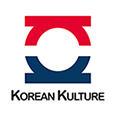Korean Culture
Korean culture has as many nuances as the topography of South Korea. This beautiful peninsula studded with some 3,000 islands has a long history, which has resulted in a unique town. Koreans are different from other Asian groups in their language, cuisine, dress, and culture.
To know the history of South Korea and its culture we must go back far back in time, some 5,000 years. The Gojoseon kingdom marks the starting point of Korean history, stained for long periods by wars and invasions by Asian dynasties and Western governments.
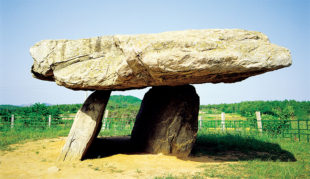
Gojoseon Kingdom
Korea’s strategic location has proven to be a disadvantage for its security. Powerful governments have wanted to dominate it, and as a defensive resource, South Korea has almost completely isolated itself from the rest of the Asian countries. This has undoubtedly contributed to making Korean culture unique and special.
A clear example of this uniqueness is its language. Although it is classified as an Altaic language, linguists recognize that it is an isolated language. Actually, it is not related to any other language. All the traditions and the varied ancestral Korean art coexist to this day with the modernity of the populous South Korea.
Korean traditional arts
Korean culture is captivating, whoever sees a Korean dance for the first time is sure to be speechless, it is a display of art, harmony and color. One of these dances, perhaps the most popular, is the crane dance. It was created in imitation of these beautiful birds that have wintered in South Korea for centuries.
Traditional music (Gugak)
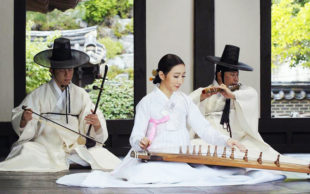
Traditional music – Gugak
Korean traditional music and other arts, such as song and dance, are grouped together and named with a single term “Gugak”. This term was coined by the Jangagwon government agency, created by the Joseon dynasty, in order to preserve Korean music and distinguish it from foreign music.
The Gugak has its classification according to the type of music in question. In this sense, we can distinguish:
- Legitimate music (jeongak or jeongga)
- Folk music (pansori, sanjo, japga)
- Music for state events (jeongjae)
- Traditional Buddhist music (salpuri, seungmu)
- Poetic songs (gagok, sijo)
In 2012 the Korean folk song “Arirang” was listed as Intangible Cultural Heritage of Humanity. This is one of the most popular songs within the Korean people, particularly valued for its moving melodies and lyrics. This and other international awards show that King Sejong’s interest in culture is shared by the Korean people.
Traditional dance (Folk dance)
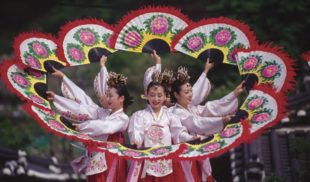
Korean Traditional Dance – Folk Dance
Dance is a fundamental part of South Korean cultural heritage. Traditional dance dates back to the Goryeo dynasty. This has undergone some modifications over the centuries. However, he continues to combine movements that mimic animals as a ritual to achieve well-being, health and fortune.
Of all the folk dances, that of the crane is the only one where masks that simulate birds are used. This dance is a ritual to longevity and contains prayers for the well-being and health of the royal family. This is one of the most striking due to the descriptive movements of the dancers imitating cranes with their outstretched wings.
Traditional dance is linked to the life of the Korean people from Greater Seoul to rural communities. We can see their performances anywhere on the peninsula, at a fair, in a large theater or in a simple farm field.
Painting and Calligraphy
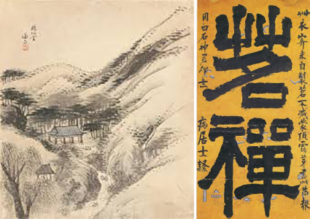
1. Korean painting. 2. Korean artistic calligraphy
The painting has represented one of the most prominent genres of Korean culture. We can trace artistic representations of painting from the Goguryeo dynasty, where the union of the human being with the cosmos is reflected with great sensitivity.
The representation of people with natural elements such as flowers and animals is typical of ancient Korean painting. Landscape idealizations in painting continued into the 18th century, giving way to more realistic paintings with depictions of everyday life.
If an artistic genre must be highlighted, it is Korean calligraphy, it is based on Hangul, which makes it unique to Korea. It is an art that mixes history with the philosophy and free thought of each writer. Among the styles of this delicate art, the following stand out:
- Panbonche (Goche)
- Honseoche
- Gungche
Korean calligraphy has evolved from the days of King Sejong to creating its own artistic patterns. Today, Korea is known as the birthplace of outstanding calligraphers. The basic elements for Korean calligraphy are known as Munbangsau: paper, brush, ink stick, ink stone. Also, a dropper is used.
Korean Crafts
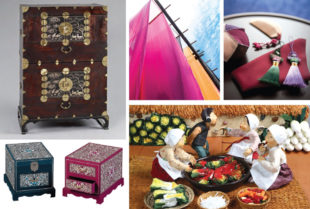
Korean traditional crafts. Photo: Korea.net
Korean crafts are very rich and it is a mixture of art and balance that is evident even in the simplest pieces of daily use. Ancestral craftsmen used natural elements to create symmetrical furniture, cabinets, drawers and wooden tables. Bamboo and wisteria were used to make harmonious baskets and mats.
The dyes and varnishes that they extracted from plants and animals were used to give color and durability to home furnishings. An artisan element that stands out in Korea is the tassel beads, it is common to see them in dresses, ornaments and home decoration.
Korean crafts have also been linked to ceremonial rites. For this reason, masks and other ceremonial objects are still seen today as part of Korean crafts.
Korean Pottery
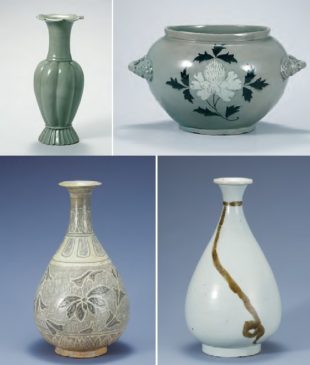
Korean traditional pottery. Photo: Korea.net
When talking about ceramics in Korea, it is impossible not to think of celadon. This is a type of pottery known as cheongja and is highly valued in Korean culture. It is characterized by its engraving technique, considered unique in its style, filled with black clay. Besides teal celadon pottery, we can find other types of Korean pottery:
- Buncheong (mud with a white coating)
- Baekja (white porcelain)
Both Buncheong and Baekja porcelain represent a variety of designs painted with highly valued pigments, such as cobalt blue imported from Persia. Korean ceramics are appreciated by great collectors around the world, for their beautiful designs achieved with ancient techniques.
Three main styles are observed in contemporary Korean ceramics. One that sticks to ancient techniques, another very modern and original, and a third style called traditional-creative. The latter is having great success in South Korea and outside of its borders. It involves the creation of pieces inspired by ancestral works with a touch of originality.
Korean traditional lifestyle
South Korea is a center of technological advancement, yet the traditional lifestyle endures in modern South Korea. It is enough to visit Seoul to understand how thousands of years old palaces can coexist with the most modern skyscrapers.
Any visitor can perceive that Korean traditions are still as alive as millennia ago; in their homes, their food, their clothing, and in their worship and religion.
Traditional dwellings – Hanok
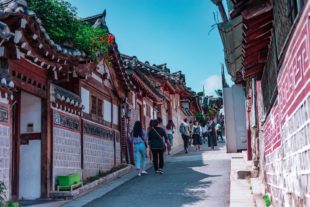
Korean traditional dwellings – Hanok.
In Korean culture, architecture stands out for its adaptation to the natural environment. Always faithful to the man-universe union, Koreans have been concerned with building homes that harmonize with their surroundings. Hanok is the typical traditional Korean dwelling.
What is special about this house? Its heating and ventilation systems are both efficient and very natural. Ondol is the heating system created with slabs that radiate heat, and maru is the mechanism to ventilate or cool the home. The Hanok are built with wood and their roofs are made of tiles made from dry straw. These hanok are very sturdy and can withstand the passing of the centuries well. An example is the Geungnakjeon Hall building, built in the 18th century and which remains unscathed to this day.
An interesting detail is that modern Korean buildings use a heating system based on the operation of the ondol of their traditional houses.
Traditional costume – Hanbok
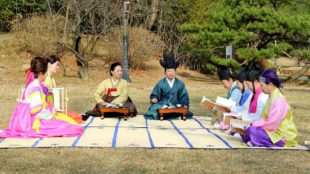
Traditional costume – Hanbok
Korean traditional dress is a reflection of their love for life and respect for values. They are discreet garments that keep good taste and modesty, known as hanbok. According to Korean history, this clothing has retained its basic design for about 5,000 years.
Today the hanbok are worn with beautiful colors and patterns although their Korean ancestors preferred the color white. At present, traditional Korean clothing is worn only for special occasions such as weddings or certain typical festivals.
This traditional dress consists of a blouse with long, wide sleeves and a skirt that reaches just below the bust, finished with a ribbon. The color of these dresses is very varied and most have delicate embroidery. The male handok is made up of a blouse (jeogori) and wide pants called javi.
South Korea is the birthplace of great fashion designers. This has generated the creation of modern styles that combine the traditional hanbok with new patterns, giving rise to the modernized hanbok.
Traditional cuisine
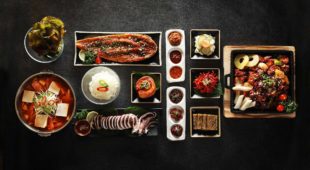
Korean traditional cuisine
Korean culture exhibits exquisite gastronomy, for a reason South Korea is compared to Italy. Food is always prepared with well-being in mind, enjoying something delicious and healthy.
The flavors that predominate in traditional Korean cuisine are intense and spicy. Fermentation has a lot to do with these flavors, fermented foods are normal in Korean cuisine. The degree of fermentation of the food depends on the taste of the food.
These are the most representative dishes of traditional cuisine in South Korea:
- Kimchi
- Bibimbap
- Bulgogi
- Ganjang
- Gochujang
- Jeotgal
- Doenjang
- Tteok
- Juk
- Janchiguksu
- Hanjeongsik
Kimchi is a traditional Korean dish well known throughout the world for its taste and nutritional value. The great variety of kimchi that we can get in Korean cuisine stands out, there are about 180 different ways to prepare this dish based on Chinese cabbage.
The flavor of this food is intense, salty and spicy and the smell of kimchi is extremely strong by virtue of the fermentation process. Among the benefits that kimchi provides are its contribution of vitamins, the control of obesity and its antioxidant power.
Traditional drinks
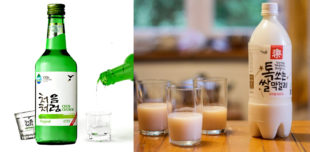
Korean traditional drinks – Soju y Makgeolli
Korean drinks are particularly strong. The alcohol content of one of these traditional drinks, soju, is around 19%. A very high AVB if it is considered that it is the most common drink to accompany meals at any time of the day.
Another popular drink in Korean culture somewhat milder than soju is the makgeolli known as Korean rice wine. This very nutritious and delicious milky white drink is the result of a fermentation process of rice in an onggi. Its flavor is unique, a thick bittersweet liquor with bitter notes. It is perfect to accompany a variety of jeon.
Nongju, as this traditional drink was previously called, has undergone some changes over the years. We can find variants of makgeolli all over Korea. The base is still fermented rice, but it is possible to find other predominant flavors among which stand out: banana, peach and cream cheese.
We cannot fail to mention cheongju among the most popular Korean drinks. This is also a rice wine but lighter than makgeolli and it is drunk cold. It is also known as chongchu, and its consumption in rituals of Korean culture is very common.
Popular Festivities
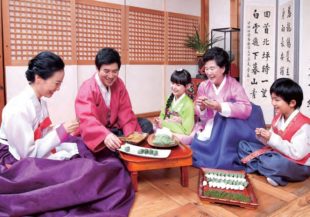
Popular festivities. Chuseok and Songpyeon. Photo: Korea.net
Most of the popular festivities in Korea have their origin in the agricultural life of this peninsula. The rites associated with land, rain, and harvests laid the foundation for the festivities of Korean culture.
All popular festivals in Korea are celebrated with special dishes, games, and dances. There are at least a dozen holidays throughout the lunar year, among the most important are:
- The first day of the new year (seollal).
- The first full moon of the year (daeboreum).
- On the 15th day of the eighth month of the lunar year (chuseok).
- The birth of Buddha.
- The weddings.
- The 60th anniversary of each person’s life.
In addition, there are 5 very important national holidays in Korean culture, each of these commemorating an important date in the independence of South Korea:
- Samijeol.
- Gwangbokjeol.
- Jeheonjeol.
- Gaecheonjeol.
- Hangul Day.
Korean weddings
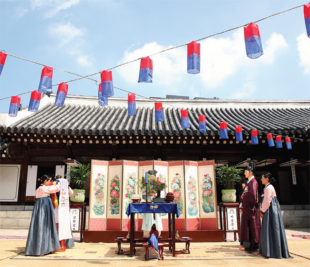
Korean weddings. Photo: Korea.net
Traditional Korean weddings are one of the most attractive and moving festivals in Korean culture. Although today they have been greatly simplified, Korean couples can still be seen in traditional costumes at their wedding ceremony. The groom wears a samagwandae, and the bride wears a beautifully embroidered wansam that is complemented by a delicate crown called a jokduri.
In the nuptial ceremony the family of the bride and groom is always present, because in Korea weddings represent the union, not of two people but of two families. For this reason, even in the most modern ceremony, the bride and groom’s family is present.
Worship and religion
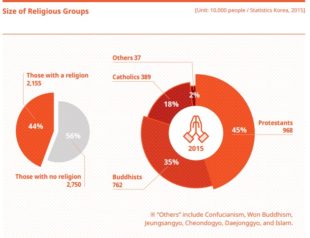
Religion in South Korea. Photo: Korea.net
Investigating the past we can find that Buddhism is the oldest form of worship in South Korea. However, we cannot claim that it is the official religion of this country. The truth is that the variety of cults and forms of worship is so varied in Korean society that there is no single official religion.
The worship of Buddha and the moral code of Confucianism are an intrinsic part of life in South Korea. At the same time religious freedom has given rise to different forms of worship such as Christianity, Protestantism and a great variety of local cults.
- Cheondoism
- Deajongism
- Buddhism Won
- Shamanism
Catholicism has been gaining ground in South Korea. Today it is the religion with the largest number of adherents, surpassing Buddhists and other religions.
The influence of Confucianism is still present in Korean culture. It can be clearly seen in the rituals performed at Seonggyoonkwan in honor of Confucius and other famous Korean Confucians.
The Korean Wave – Hallyu
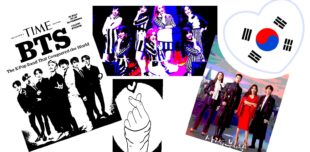
The Korean Wave – Hallyu
Hallyu has grown throughout Asia and the world like a great wave, hence the term “Korean wave.” This artistic and cultural movement became evident in the 1990s. At that time, the doors of China were opened to receive young Korean artists through television.
Korean soap operas or doramas have become very popular throughout China since 1997. In addition to these television productions, the pop music produced and sung by young Koreans has made a deep impression all over the world.
The Korean wave transcends borders and these young artists have passionate fans in the Western world. Interestingly, hallyu has had a positive effect on Korean culture. Contrary to what one might think, it has unleashed a furor among young people for learning more about their culture and projecting it through this wave.
Hallyu has even contributed to the country’s economy by promoting tourism. Now many tourists visit South Korea attracted by the popularity of its young artists, and the number of these visitors is increasing every year.
K-pop
This name is known to contemporary music, written, composed and performed by Koreans. It is a show of light, color and sound. K-pop has been gaining energy since 2000 throughout East Asia, especially in the Japanese record market.
This modern musical genre currently has more than 150 groups in South Korea. Some of these groups are: Wanna One, BTS, Big Bang, Girls Generation and TVXQ. It groups together several musical genres, such as hip-hop, rock, pop dance, R and B, among others.
Currently there are big K-pop concerts in and outside of Korea, these events draw large crowds of young people identified with the Korean wave. Many of the Korean groups participating in these events have been awarded national and international awards. An example of this is the band BTS, winner of an award at the 2019 Billboard Music Awards.
Korean series – Dorama

Korean series – Dorama
Korean series have earned a very special space in eastern and western homes. Dramas captivate for their realism and naturalness, and for the beauty of their characters. Regardless of whether the plot takes place in a simple rural setting or in modern Seoul, they are immersive stories. Nobody wants to miss a single detail of them.
Dorama project Korean culture in every corner of the world. Food, lifestyle, and family values are commonly depicted in Korean productions. Some of these television series are framed in the history of Korea and showcase the traditional dress and lifestyle of their ancestors.
Titles like “Descendants of the Sun” and “Love in the Moonlight” are some of the most renowned dramas on the Korean wave. The latest Korean series continue to be successful in both the East and the West. Among the most awarded are:
- Sunshine.
- That winter, the wind blows.
- It’s Okay to not be Okay.
- When the camellia blooms.
- Crash landing on you
Korean cinema

Korean cinema
Cinema has a long history in Korean culture, it is more than a hundred years of hard work and today they are reaping what they have sown. Proof of this is the recognition of Korean cinema at major international film festivals, such as Cannes, Venice and the Berlin festival.
Undoubtedly, this international recognition has been boosted by film festivals held in South Korea itself. Great hallyu conductors and artists have hosted such important festivals as BIFF, JIFF and BiFan.
These are some of the Korean film productions that have surprised by their unique storytelling and unpredictable scripts:
- The man without a past.
- Parasites.
- Train to Busan.
- The maid.
Of course, technology has given Korean culture a huge boost through the use of platforms like OTT. This platform has made it possible to project culture through cinema in more than 35 countries, with a great reception.
Korean culture is rich, unique and very special, and it will undoubtedly continue to be talked about around the world.
